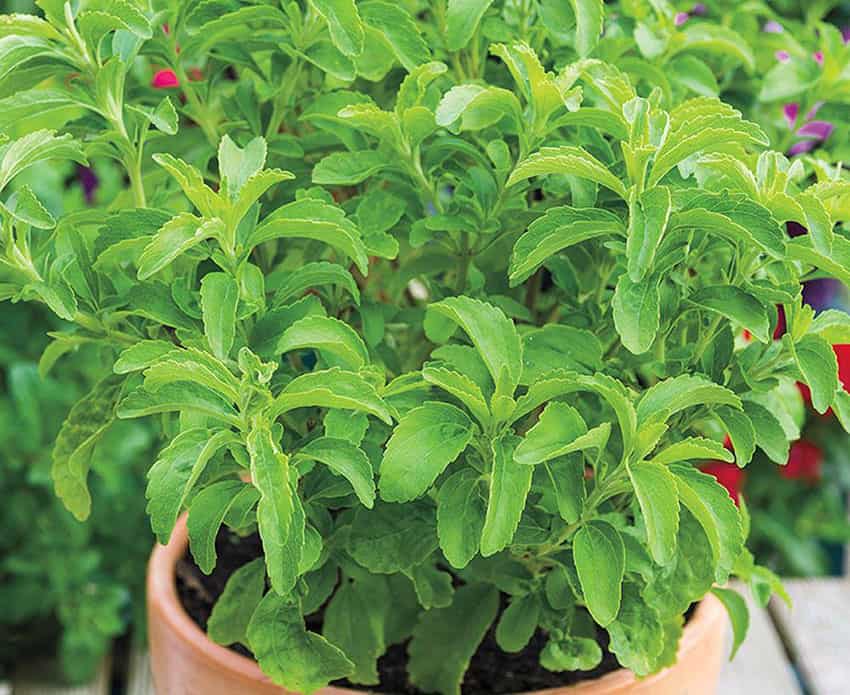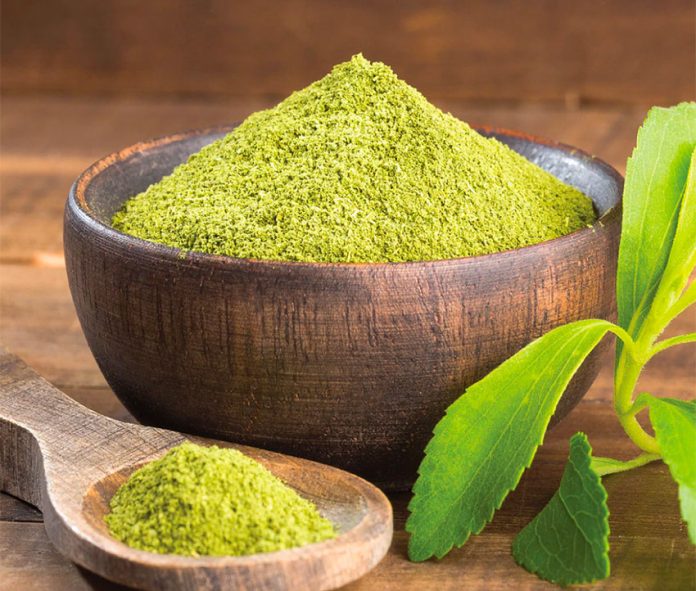If you’re one of those people who can’t or don’t want to eat refined sugar but still want a sweetener now and then, it is likely you’ve been happy to discover stevia, a naturally sweet plant whose leaves can be ground and used to sweeten just about anything.
Pure stevia is about 200 times sweeter than sugar and gets its sweetness from natural compounds in the plant called steviol glycosides.
Is it better than “real” sugar or artificial sweeteners like Splenda? Well, it’s certainly safer and more natural, and has no calories (or nutritional value). Some people, myself included, detect a slight bitter aftertaste that’s unpalatable, but the majority of folks who use it swear by it.
Splenda, the most common low-calorie artificial sweetener, is 450-650 times sweeter than sugar. It’s created chemically in a base of sucralose — an indigestible artificial sugar — by replacing some of the atoms in sugar with chlorine. Now I have to say that all makes me shudder, but hey, to each his own.
Back to stevia. The bad news is that a flood of products claiming to be stevia have saturated the market. Sadly, stevia products available in Mexico are not above suspicion. There’s a lot of money to be made by jumping on the newest food trend bandwagon, and Mexico’s labeling laws are notoriously lax.
And food manufacturers know the average consumer is too busy to read labels: “Studies show that the color of the packet is the most important factor in sweetener selection.”
Here’s an example: the little green and white packets of “Svetia” contain only 2.5% crystallized stevia in a base of 97% other sugars. The ingredients list, in the teeniest, tiniest font on the back, says: dextrose, fructose and a complex phrase that means “crystallized” stevia. And this in a product approved by the AMND, the Mexican Association for Diabetic Nutrition!
So do your homework, folks – your health is worth the effort! Especially if you’re diabetic, read labels carefully and spend the little bit of extra money to get what you’re really looking for.
Another option is to find a local grower and make your own sweetener from fresh stevia leaves (not the stems or flowers). You can even grow your own – stevia is a pretty, leafy plant that’s easy to grow, in containers or in the ground, especially in Mexico, where it’s a perennial. And turning the leaves into a sweetener is as easy as drying and grinding them, or cooking them into a simple syrup or extract.
Bear in mind that you can’t just replace sugar with stevia in baking; whatever you’re making won’t have the same texture or browning, and you’ll need to tweak the temperature (lower) and cooking time (longer). Searching on Google will yield an abundance of adjusted recipes. This YouTube video has step-by-step instructions on harvesting and making stevia powder and liquid sweetener.
If you buy stevia powder, it will be white because of the extraction process, and about 300 times sweeter than sugar. Homemade stevia powder – from dried and ground leaves – will be a lovely green color, slightly less sweet and not as bitter as the store-bought.

While you can just crumble the dried leaves by hand to make a fine powder, an electric coffee grinder works best. (Of course, one that’s not used for coffee!) Sweeteners made from fresh dried stevia leaves will have a dark green color and may tint whatever you use them in a little bit.
Here are some basic conversions, but you’ll have to find the amount of stevia that’s to your sweetening taste. Just remember, a little goes a long way!
Conversion chart
1 cup sugar = 2-4 tsp. stevia leaf powder or 1 tsp. stevia extract.
1 Tbsp. sugar = ¼ tsp. stevia powder or 6-9 drops stevia extract.
1 tsp. sugar = Pinch of stevia powder or 2-4 drops stevia extract.
Fresh stevia powder
Pick leaves off stevia plant, discard stems. Dry leaves for about 12 hours in the sun or use a food dehydrator. Once leaves are dry, grind them in a food processor or coffee grinder to make pure stevia powder.
Stevia extract
- 1 glass jar with a tight-fitting lid
- Dried stevia leaves, crumbled or powdered
- Vodka or rum
Using a ratio of 2 parts stevia to 3 parts liquid, place one cup of stevia in the jar and cover it with 1-1/2 cups of the alcohol. Shake the mixture well and let it sit at room temperature for 24 hours. Strain through muslin or a coffee filter, then simmer the mixture on low heat for 30 minutes, stirring regularly, to remove the alcohol. Be careful not to boil. Remove from heat, cool and store in a dark colored bottle for up to 6 months or indefinitely if refrigerated. —Recipe courtesy www.preparednessmama.com
Stevia syrup
- ½ cup dried stevia leaves, crumbled
- 2 cups warm water
Place stevia and water in a glass jar and let steep (unrefrigerated) for 24 hours. Strain leaves from mixture. Cook the remaining liquid on low heat, reducing to a concentrated syrup. Store in an airtight container in refrigerator for up to six months.
Liquid stevia sweetener
- ¼ cup pure stevia powder (made fresh, not from packets)
- 1 cup warm water
Place in glass jar, shake till mixed. Let sit on counter for 24 hours. Refrigerate and use to sweeten drinks, etc.
Janet Blaser of Mazatlán, Sinaloa, has been a writer, editor and storyteller her entire life, and feels fortunate to write about great food, amazing places, fascinating people and unique events. Her work has appeared in numerous travel and expat publications as well as newspapers and magazines. Her first book, Why We Left: An Anthology of American Women Expats, is available on Amazon. Contact Janet or read her blog at whyweleftamerica.com.
